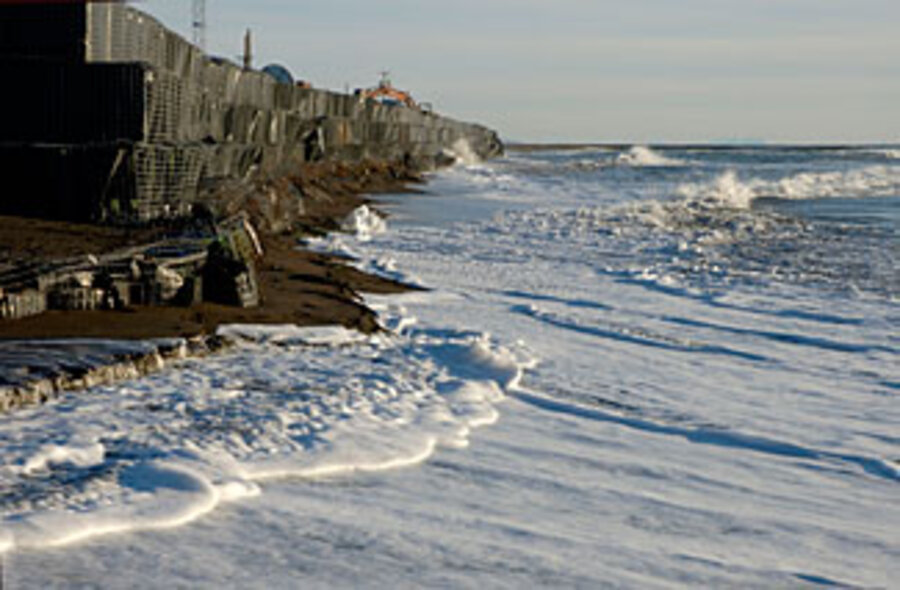Alaska oil's new 'Gulf of Mexico'
| Anchorage, Alaska
The treacherous, ice-choked waters off Alaska have long lured risk-taking fortune hunters seeking furs, fish, or other riches.
Merchant marine companies in the 19th century were so intent on pursuing the lucrative whale-oil and baleen trade that they were willing to lose entire ships, and they did. Vessels were occasionally crushed by masses of shifting sea ice.
Today, the prize is petroleum.
Inspired by higher prices, new technology, and the inescapable fact that Alaska's onshore fields are running dry, companies have put up billions of dollars to start the search for oil and gas in the lightly developed, federally managed Alaska outer continental shelf (OCS). In all, the OCS could hold oil in quantities similar to that at Prudhoe Bay – the oil field that has fueled Alaska's economy for four decades.
Yet those forces of nature so brazenly flouted by traders centuries ago, coupled with the new stresses from a rapidly changing Arctic climate, are giving environmentalists and Inupiat Eskimos pause. If boosters consider the OCS to be the next Prudhoe Bay, critics fear it could be the next Exxon Valdez.
Lawsuits have already forced oil companies to pare back or delay drilling plans. But with the Obama administration set to review offshore drilling rights in the region – promising a balance of economic and environmental needs – the issue is now coming to a head.
The US Minerals Management Service estimates the entire Alaska OCS – the waters stretching from three to 200 miles offshore – holds 27 billion barrels of oil. Almost none has been touched by a drill bit.
The most promising section of the Alaskan OCS could be the Chukchi Sea – the largely ice-covered expanse between northwestern Alaska and northeastern Russia. Also a target is the Beaufort Sea off the north coast.
Industry representatives say they are only beginning to grasp the enormous hydrocarbon potential of the area, once considered too far and too forbidding to justify investment. Only five wells have ever been drilled in the Chukchi. In the similar-sized Gulf of Mexico, the number is nearly 50,000, notes Rick Fox, Alaska asset manager for Shell, the company leading the charge into Alaska's OCS.
Shell has so far spent $2.5 billion in an effort to establish offshore Alaska as a major global operating center. This includes $2.1 billion for Chukchi leases in a record 2008 sale.
Alaska politicians are gung-ho supporters of OCS development, even though OCS oil would provide no royalties or production-tax dollars to the state, since it is federal territory. The reason: Without OCS oil, the 32-year-old Trans Alaska Pipeline System (TAPS) faces a grim future. It is running at one-third of its capacity.
"We are quickly approaching the minimum throughput rate, beyond which the flow of oil cannot be maintained. Without development of new sources of Alaskan oil, TAPS could shut down within the next decade," Gov. Sean Parnell said in a Sept. 3 letter to Interior Secretary Ken Salazar, who is mulling the Obama administration's national offshore-drilling strategy.
Inupiat Eskimos, however, have long opposed OCS drilling. They see it as a threat to their culture, which is founded on whaling and harvests of other marine mammals and fish.
"That's pretty concerning to us because of the damage that will cause to our 'garden,' " says Caroline Cannon, president of the tribal council for Point Hope, the Chukchi Sea whaling village believed to be the oldest continually occupied community in North America.
Oil spills and leaks will be impossible to clean up once they seep in and around the broken ice that doomed mariners in the past, say critics. They are unmoved by industry claims of improved technology demonstrated in hostile climes like the North Sea or the hurricane-prone Gulf of Mexico.
"That's what Exxon told us in Prince William Sound," says George Edwardson, president of the Barrow-based Inupiat Community of the Arctic Slope, another tribal government.
Risks go beyond spills, critics say: The din emitted by seismic tests and other operations will drown out whale calls and, possibly, injure or deafen marine mammals, while air pollution and air and marine traffic will cause further disruptions.
That would be amid stresses already evident from global warming, which has amplified impacts in the Arctic. Climate upheavals that are already imperiling polar bears, Pacific walruses, and other wildlife are obvious to residents, Cannon says.
"We've seen dramatic changes in the thickness of the ice," she says. "We're having rainy weather in January."
A series of lawsuits and administrative challenges has been filed by organizations ranging from small environmental groups to the North Slope Borough – the local government for the Minnesota-size district of northernmost Alaska.
One result was a court ruling that forced Shell to back down from its plan to drill more than a dozen wells over three years at two Beaufort prospects. Another ruling cast doubt on the entire 2008 lease sale. In that case, an appeals court in Washington, D.C., found that the Bush administration's leasing program was flawed and "irrational." It is unclear whether the leases sold then will have to be modified or even voided.
Now it is up to Mr. Salazar to review Alaska's entire offshore oil and gas future, not just in the Chukchi and Beaufort seas but also in the salmon-rich Bristol Bay and Cook Inlet areas, where the Bush administration had scheduled lease sales.
Stymied by the legal challenges, Shell is trying to win over locals. In response to Inupiat advice about whales' disdain for the color red, Shell ordered its vessels painted blue and white. The company has allowed its facilities and equipment to be used for local search-and-rescue missions. And the Arctic Slope Regional Corp., a for-profit corporation owned by many of the same Inupiat residents whose tribal governments formally oppose offshore development, is a major contractor.





